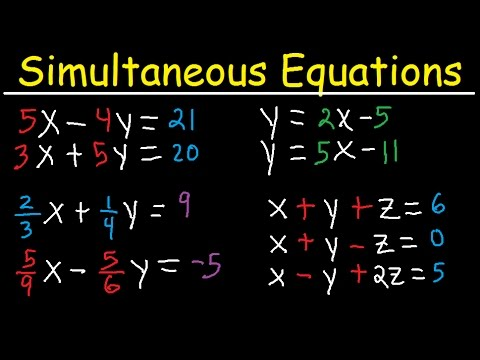In This Post I Will talk About How To Solve Simultaneous Equations This article aims to teach you strategy on the topic of resoling simultaneous equations in a step-by-step method for clarity.
This tutorial is tailored for students cognizant of the basics along with professionals looking to brush up their skills.
I will equip you with precise techniques and useful advice that will allow you to discover solutions for varying equations simultaneously.
What Are Simultaneous Equations?
A simultaneous equation is two or more equations which contain the same variables and are solved at the same time. In the cases where solutions exist, simultaneous equations are most common with two or more unknowns, typically involving x and y.
These equations are essential in determining values of variables from given relationships. like computing costs, speeds, or any other quantities. A unique solution exists if the lines intersect; no solution if lines are parallel; infinitely many solutions if the lines overlap completely.
How To Solve Simultaneous Equations
One Platform Example: How To Solve Simultaneous Equations
Let’s use a simple online calculator platform, like Symbolab, to solve: {2x+y=73x−y=8\begin{cases} 2x + y = 7 \\ 3x – y = 8 \end{cases}
Steps:
Go to symbolab.com and select “Simultaneous Equations Solver.”
Enter the equations into the boxes:
2x + y = 7
3x - y = 8
Click “Solve.”
Result:
The platform calculates and shows: x=3,y=1x = 3, \quad y = 1
It also provides step-by-step workings, which help you learn the elimination or substitution process visually.
Tip: Many platforms (like WolframAlpha, Mathway) work similarly—great for double-checking your manual work!
Why Solving Them is Important
Simultaneous equations capture quantitative relationships around us and solving them gives us insight to real life problems. Real life tasks which involve mixing solutions, planning business production or estimating costs require interdependent factors. In engineering and science, they create models with multi-faceted systems.
In economics, balancing the parameters of two or more economical elements like a demand and supply curve. Even mundane activities like comparing rates and sharing the bills involve simultaneous equations.

Mastering problems composed of multiple equations will allow you to unlock complex issues and enhance your predictive power while deepening your comprehension of varied interdependent factors. To put it in simple terms, the equations enable us to reason step-by-step and provide sound decisions.
Common Mistakes to Avoid
- Solutions were not verified in original equations provided.
- Incorrect variable isolation causing wrong substitution or elimination.
- Arithmetic mistakes in addition, subtraction or multiplication of equations.
- Ignoring proper alignment of terms leading to elimination mistakes.
- Ignoring signs (plus or minus) when rearranging or simplifying.
- Overlooking non-linear simultaneous equations results in multiple solutions.
- Not recognizing parallel lines means fails to acknowledge no solution.
- Answering too early using decimals causes rounding off errors.
- Omitting steps or solutions make tracing mistakes more difficult.
- Failure to orderly rewrite equations increases confusion with like terms.
Conclusion
To wrap up, resolving simultaneous equations brings out the solving of several parameters that is done together. Solving problems using substitution, elimination, or graphical methods makes handling such problems organized and efficient.
Ensure you validate your results by substituting them back into the original equations. You will gain confidence with practice and solve even very complicated systems quickly and accurately. Keep learning to hone these important skills!
FAQ
Can you solve non-linear simultaneous equations the same way?
How can I check my solutions?
What if my equations have no solution or infinite solutions?
Infinite solutions: lines are the same (dependent).










